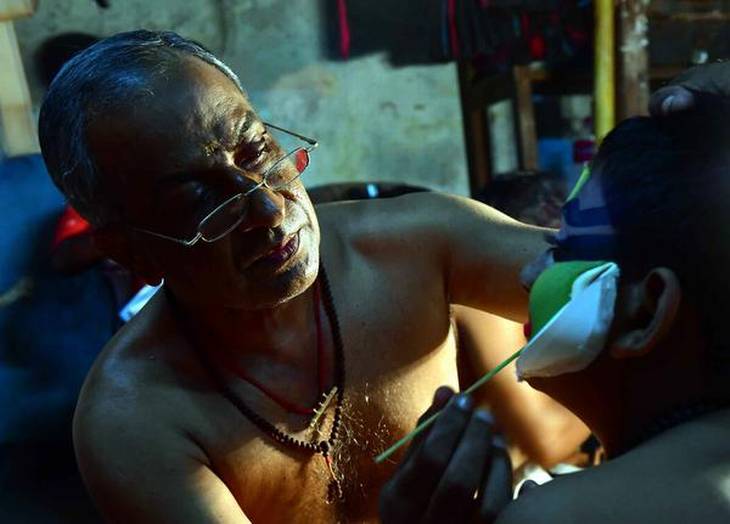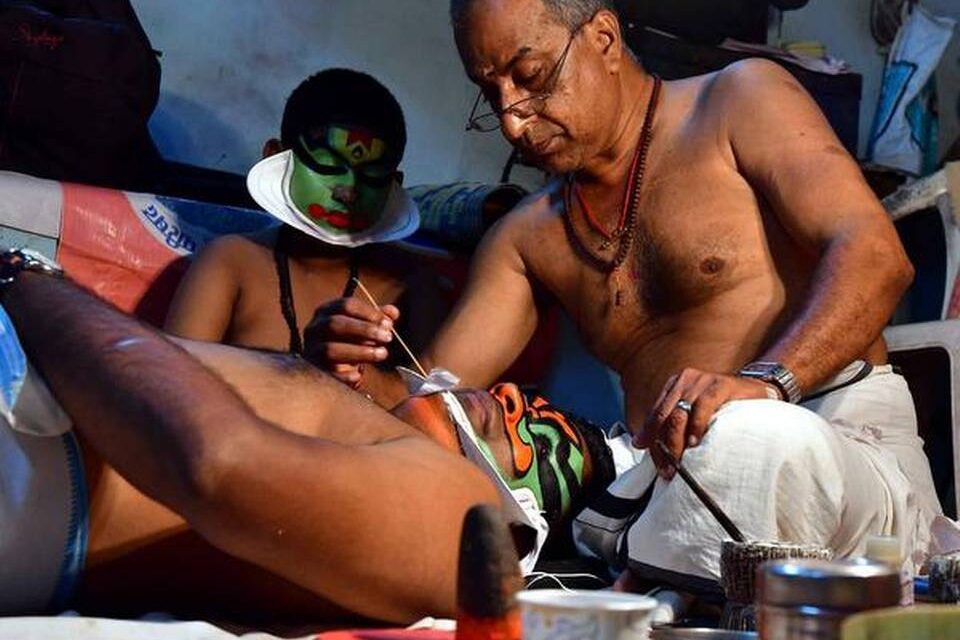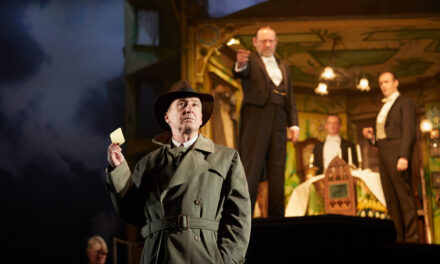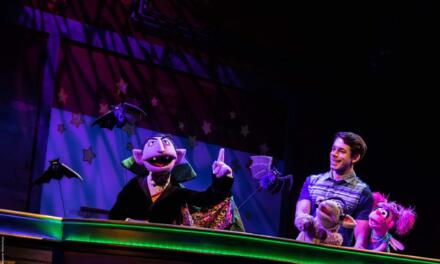For more than three decades, the artist has been applying the intricate and distinctive make-up of Kathakali artistes.
Sitting cross-legged on the floor, Margi Raveendran Nair’s hands are rock steady as he carefully draws thin white stripes on a black background. Eyebrows furrowed and lips pursed, he is a picture of concentration as each white line is added to complete the chutti (make-up) of Sadanam Vishnuprasad playing the role of the villainous Nivathakavachan in Kalakeyavadham Kathakali for a play at Margi Natyagriham in the city.
With hardly discernible but fluid circular movements of his wrist, he applies the white-coloured rice paste as slim ridges on the actor’s face. A thin, pencil-like wooden stick is dabbed into a container filled with the white paste and then applied as dots, stripes and curves on the black base.
“The black is lamp black that we make ourselves. The white paste is obtained by grinding rice to the required consistency and mixing with lime in the right proportion. Even today, the right way to make the colours — green, yellow, black, blue and white — is from natural ingredients. Stones, herbal powders and natural powders are mixed with sesame oil or coconut oil. The dried seeds of the chunda poo (Solanum indica with light violet flowers) is used to redden the eyes. It takes about three to four hours for the chutti,” explains Raveendran.

Margi Raveendran Nair. Photo Credit: S Mahinsha.
The green room of the heritage Margi Natyagriham at East Fort resembles an artist’s studio. Under the glare of a lamp-holder with several bulbs, two chutti artists apply the intricate make-up of two of the villains of the play. With his head on the lap of the chutti artiste, the actor playing the demon Kalakeya is in the midst of a power nap during his make-up, quite oblivious to the artwork coming alive on his face. Vishnuprasad silently observes the coming and going of people while he is in the midst of his make-up. Arjuna, the hero of the play, is putting the finishing touches to his predominantly green make-up (pacha or green indicates heroic characters). Tiny pots of coloured pastes, rags, wooden sticks, eerkkil (midrib of the coconut palm) and more are scattered on the floor while a traditional lamp has been lit in a corner of the room.
Learning From Titans
Kathi, as the character of terrible villains is known in Kathakali, is the most difficult to work on, says the 59-year-old chutti artiste and manager of Margi, a cultural organization in Thiruvananthapuram promoting and teaching traditional art forms of Kerala.
Since 1979, he has been applying the distinctive, elaborate make-up of Kathakali characters that identify them on stage as hero, heroine, sage, comic, villain and so on. “I had trained to be a Kathakali actor from the age of 11, as my father, Krishna Pillai, was a huge fan of the art form. Since my arangettam(maiden performance on stage), I have shared the stage with several titans of the art form such as Kalamandalam Krishnan Nair aashaan, Mankulam aashaan, Chennithala Ramakrishan Pillai aashaan, Madavoor aashaan… In 1979, I became a part of Margi and began learning the art of chutti and vesham (costuming) from RLV Somnath, who was the then in-charge of Margi. Mankulam Vishnu Namboodiri aashaan, then a faculty member in Margi, gave me ample opportunities to learn both chutti and vesham,” he recalls.
In addition to learning how to make the colours and apply them, he had to master ornamentation of the crown and the right way of donning costumes. After completing the two-year course in chutti and vesham, he began working on the make-up of a galaxy of actors who became household names in Kathakali. The visage of greats such as Kalamandalam Krishnan Nair, Padmanabhan Nair, Kalmandalam Ramankutty Nair, Kalamandalam Gopi, Keezhpadam Kumaran Nair… became his canvas as he transformed them into epic heroes, nymphs, kings, queens, warriors, blackguards, demons and more. At the recently concluded Nishagandhi festival too, Raveendran Nair was there, applying the colours for the leading men.
“Although certain things have not changed much when it comes to the make-up of Kathakali, there have been some significant changes. I have heard that in the olden days, the white chutti, extending from one cheek to the other, was made of rice flour. Now, it is made of paper. Moreover, the resin of raw banana was used as a kind of gum. Now, we all use spirit gum on the face,” he adds. All set to retire from work next year, the veteran plans to spend his time watching plays and carrying on his work as a chutti artiste.
Does he regret not making it big as an actor? “No,” he asserts. Raveendran Nair is all smiles when he says that as part of Margi, he has seen the world. “It has been a colourful journey,” he adds.
This article was originally posted at thehindu.com on December 2nd, 2019 and has been reposted with permission. To read the original article, click here
This post was written by the author in their personal capacity.The opinions expressed in this article are the author’s own and do not reflect the view of The Theatre Times, their staff or collaborators.
This post was written by Saraswathy Nagarajan.
The views expressed here belong to the author and do not necessarily reflect our views and opinions.

















